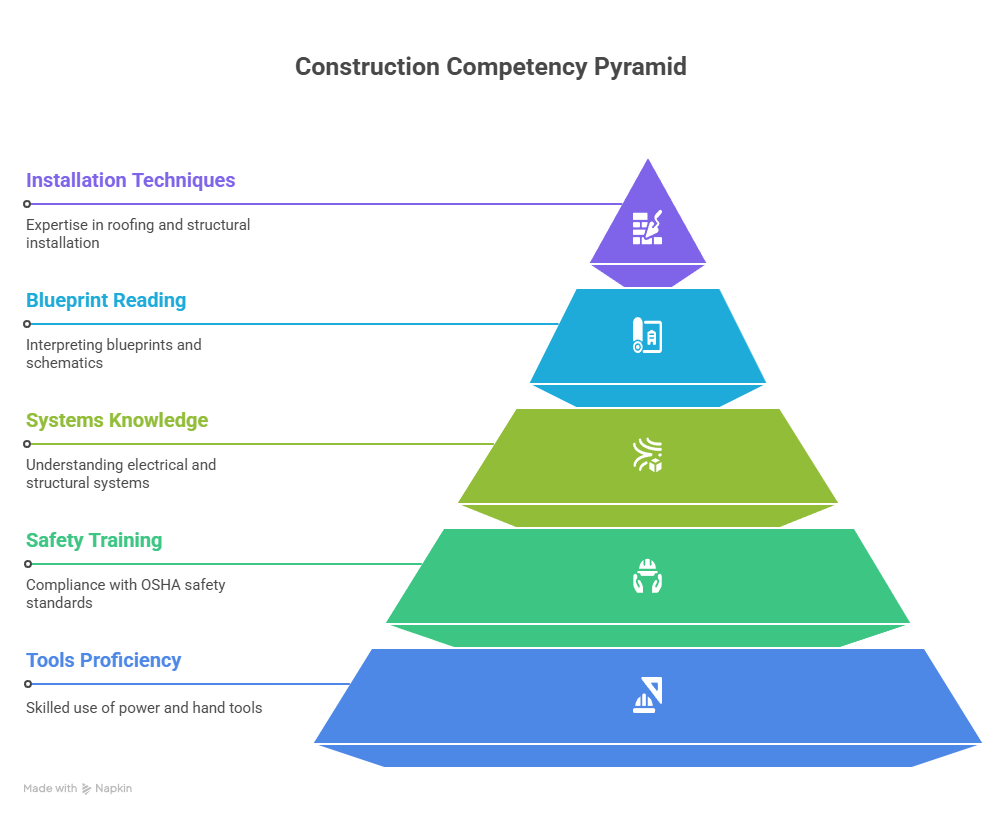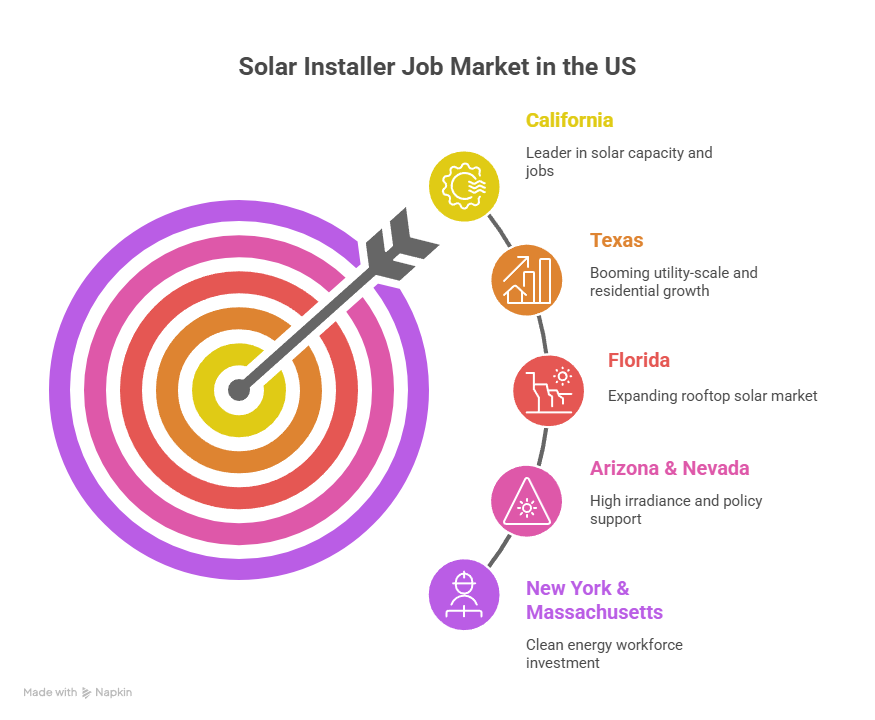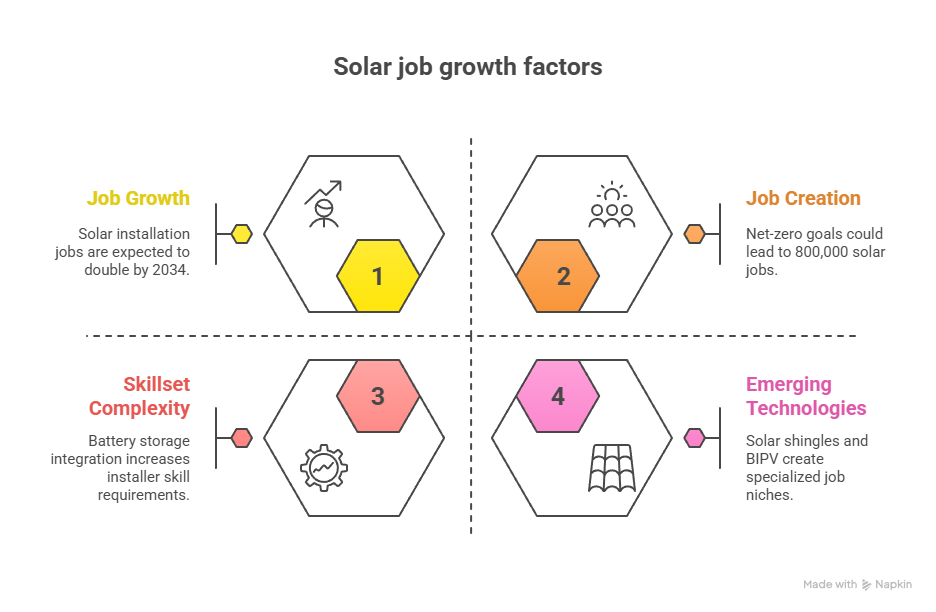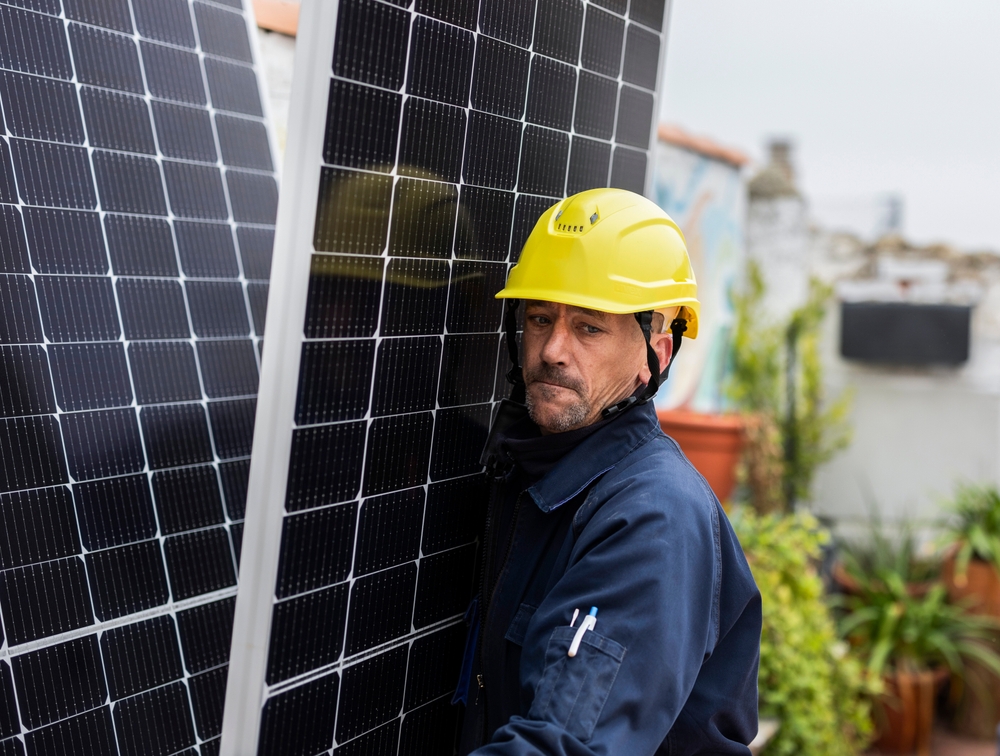
What It Takes to Build a Solar Workforce
The solar industry is no longer a niche sector. It has become one of the fastest-growing components of the global energy mix, and at the heart of this expansion are solar photovoltaic (PV) installers. These skilled workers are responsible for setting up, maintaining, and sometimes repairing solar panel systems on rooftops, solar farms, and commercial buildings.
According to the U.S. Bureau of Labor Statistics (BLS), the employment of solar PV installers is projected to grow 22% from 2022 to 2032, much faster than the average for all occupations. This surge is driven by declining solar technology costs, state and federal incentives, and increased public awareness about sustainable energy.
However, with rapid growth comes a significant challenge—meeting labor demand. Solar companies, from utility-scale developers to residential installers, face increasing pressure to recruit, train, and retain a skilled solar workforce. Staffing solar installers has become a top priority for HR departments, temp agencies, and training organizations aiming to align workforce capacity with market opportunity.
What Do Solar Installers Do?
Solar PV installers typically perform the following tasks:
- Assessing site locations and structures for system suitability
- Installing solar panels, inverters, and mounting equipment
- Connecting systems to the electrical grid or battery storage units
- Performing maintenance and repairs on older systems
- Ensuring compliance with local electrical and building codes
The job combines mechanical aptitude with basic electrical knowledge, safety compliance, and problem-solving skills. While some installations follow standardized layouts, others require custom engineering and adaptability based on roof structure, orientation, and system size.
Installers often work at heights and in variable weather conditions. As a result, physical fitness and attention to safety procedures are essential.
Skills and Certifications That Matter
A typical entry-level solar installer may only need a high school diploma or equivalent, but many employers prefer candidates with additional certifications or technical training. Programs like the North American Board of Certified Energy Practitioners (NABCEP) certification add credibility and improve job placement prospects.
Core competencies for success include:
- Electrical systems knowledge
- Blueprint and schematic reading
- OSHA safety training
- Roofing and structural installation techniques
- Power tools and hand tools proficiency
Soft skills like teamwork, reliability, communication, and customer service are also crucial, especially for residential projects where installers often interact directly with homeowners.
As solar technology becomes more advanced—with battery storage integration, smart grid interfaces, and higher-efficiency modules—installers are expected to evolve their skill sets as well.

What Does It Take to Become a Solar Installer?
To become a solar installer, you typically need a combination of technical training, hands-on experience, and basic electrical knowledge. While some start as general laborers, most employers prefer candidates who have completed a training program or apprenticeship.
Key qualifications include:
- High school diploma or GED (required)
- Technical training in solar PV systems (often through trade schools or community colleges)
- OSHA 10 or OSHA 30 certification for safety compliance
- NABCEP (North American Board of Certified Energy Practitioners) credential (optional but recommended)
No four-year degree is needed. That makes solar installation one of the few high-growth careers accessible without college debt.
How Long Does It Take to Train as a Solar Installer?
Training to become a solar installer can take as little as 4–12 weeks depending on the program. Accelerated bootcamps, online modules, and community college certificates are popular pathways.
Timeline examples:
- Short-term bootcamp: 4–8 weeks (intensive, hands-on)
- Technical certificate: 3–6 months (includes safety, electrical basics, and solar system setup)
- Apprenticeship: 6–12 months (on-the-job training with mentorship)
This fast-track setup makes it an appealing option for individuals changing careers or entering the workforce quickly.
Are Solar Installer Jobs in Demand?
Yes. Solar installer jobs are in high demand across residential, commercial, and utility-scale solar projects.
Recent data trends show:
- Over 30% of solar companies report difficulty filling installer positions
- The U.S. solar workforce is projected to double by 2030 to meet clean energy targets
- Employers in states like Texas, California, and Florida are particularly aggressive in hiring
This demand creates favorable conditions for job seekers and provides leverage for negotiating wages, benefits, and career development opportunities.
Do Solar Installers Make Good Money?
Solar installer salaries are competitive, especially when factoring in rapid advancement potential. According to labor statistics:
- Entry-level: $18–$22/hour
- Mid-level (2–5 years): $24–$30/hour
- Experienced/crew lead: $60,000–$75,000/year or more
Earnings can vary by region and project size. For example, commercial and utility-scale solar jobs typically pay more than small residential installs. Overtime, per diem pay, and project bonuses are also common in large-scale work.
What Are the Career Paths for Solar Installers?
While solar installers often begin in entry-level roles, the profession offers strong upward mobility. After gaining 1–3 years of experience, many installers move into supervisory or specialized positions.
Common advancement paths:
- Crew Lead / Foreman: Oversees job sites and manages team performance
- Project Manager: Handles scheduling, budgeting, and permits
- Solar Sales or Site Assessor: Uses field knowledge to consult and close deals
- Solar Designer / Engineer Assistant: Moves into planning or design roles with further training
- Battery / Storage Technician: Specializes in hybrid and off-grid systems
Upskilling through online certifications and hands-on experience is often sufficient to move into these roles without a formal degree.
Where Are the Most Solar Installer Jobs?
Solar jobs are concentrated in states with strong renewable energy mandates and generous solar incentives. These states typically have year-round sunlight, large residential populations, or aggressive utility-scale deployment.
Top states for solar installer jobs:
- California: #1 in total solar capacity and number of jobs
- Texas: Booming utility-scale market and strong residential growth
- Florida: Expanding rooftop solar due to low barriers to entry
- Arizona & Nevada: High irradiance and consistent policy support
- New York & Massachusetts: Focused investment in clean energy workforce development
Emerging states like Illinois, Virginia, and Colorado are also investing in green jobs pipelines.

How Can Companies Hire Qualified Solar Installers Quickly?
For solar companies trying to meet tight project deadlines, hiring qualified installers quickly is a critical business objective. Delays in labor onboarding can mean project overruns, missed tax credit deadlines, or lost clients.
Proven hiring strategies include:
- Partnering with trade schools: Build a direct recruitment funnel from training programs
- Using solar staffing agencies: Get pre-vetted candidates with proper certifications
- Offering on-the-job training: Attract entry-level workers and upskill them internally
- Implementing referral bonuses: Use your current team to recruit their peers
- Hiring seasonally or regionally: Adjust to project cycles and geographic expansion
Speed-to-hire is becoming a competitive differentiator as labor tightens.
What Should Employers Look for When Staffing Solar Installers?
When staffing for solar installation roles, employers need to evaluate both technical competency and jobsite readiness. It’s not just about who can use a drill—it’s about finding reliable team members who can perform safely and efficiently under pressure.
Top traits and skills to look for:
- Familiarity with basic hand tools and power tools
- Willingness to work at heights and in variable weather
- Understanding of electrical systems (even basic)
- Ability to follow blueprints or diagrams
- Teamwork and communication skills
- Valid driver’s license and clean background (often required)
A good solar installer can follow instructions, solve field challenges, and keep the work moving without constant supervision.
What Are the Biggest Hiring Mistakes in Solar Staffing?
Some of the most common hiring mistakes in solar staffing can lead to delays, rework, and even liability issues. These include:
- Skipping safety certification: OSHA compliance is mandatory, not optional
- Underestimating physical requirements: Solar installation is labor-intensive
- Hiring based only on availability: A warm body doesn’t mean a good fit
- Failing to match crew experience to project type: Utility vs. residential requires different pacing
- Overlooking soft skills: Installers are often the face of the company on-site
Avoiding these errors through pre-screening, trials, or pairing new hires with veterans can make a major impact on team performance.
How Do Staffing Agencies Help Solar Companies Grow?
Solar staffing agencies specialize in filling temporary, permanent, and contract roles within the clean energy space. They help companies avoid lengthy job postings, resume reviews, and onboarding headaches.
Key benefits of working with a staffing agency:
- Faster access to trained, job-ready talent
- Workforce scalability without full-time HR overhead
- Better candidate-vetting through niche-specific screening
- Seasonal hiring flexibility during demand spikes
- Compliance with local labor laws and certifications
For fast-growing companies, this can create a scalable hiring model without sacrificing quality or compliance.
What Is the Outlook for Solar Installer Jobs in the Next 10 Years?
The long-term forecast for solar installer jobs remains highly positive. Driven by climate legislation, falling hardware costs, and corporate sustainability mandates, solar is expected to become the dominant source of new electricity capacity in the U.S. within a decade.
According to projections:
- Solar installation jobs will grow more than 2x by 2034
- Over 800,000 solar-related jobs may be created if net-zero goals are pursued
- Battery storage integration will increase the complexity (and value) of installer skillsets
- Emerging technologies like solar shingles and BIPV (building-integrated photovoltaics) will create new niches
Installers who learn to work with evolving tools, storage systems, and smart grid platforms will be especially in demand.

Labor Shortages and Demand-Supply Imbalance
While solar employment is growing, the availability of trained workers has not kept pace. The Solar Energy Industries Association (SEIA) estimates that over 250,000 Americans currently work in the solar industry, but workforce demand could exceed 400,000 by the early 2030s if current growth trends continue.
Some key factors contributing to the labor gap include:
- Aging skilled trades workforce across sectors
- Competition from other industries like construction and electrical contracting
- Limited awareness of solar careers among young job seekers
- Geographic mismatches between labor pools and project locations
- Regulatory hurdles that delay hiring and training processes
These dynamics create wage pressure and contribute to project delays, especially during peak installation seasons. Solar staffing is no longer just a logistics issue—it’s a strategic concern for sustainability, scalability, and profitability.
Wages and Career Progression for Solar Installers
Wages for solar PV installers vary based on experience, region, and specialization. According to BLS data, the median annual wage in 2023 was around $48,000, with top earners bringing in over $70,000.
Entry-level workers typically start as laborers or apprentices, with upward mobility into crew leads, field supervisors, project managers, or even system designers with further education or certifications.
Some solar professionals choose to specialize in areas such as:
- Electrical integration
- Battery storage
- EV charging station installation
- Commercial system installation
- Solar farm operations and maintenance
This makes solar installation an attractive profession for those seeking long-term career growth in the green economy.
Geographic Hotspots and Workforce Migration
Solar job opportunities are not evenly distributed across the United States. States with favorable policy environments, high solar irradiance, and robust renewable portfolios dominate job growth. California, Texas, Florida, and Arizona consistently rank among the top states for solar employment.
However, new solar incentives under the Inflation Reduction Act (IRA) are encouraging expansion into the Midwest, Northeast, and even coal-transition regions. These emerging markets require targeted workforce migration and local training programs to ensure labor readiness.
The challenge is ensuring that as solar spreads geographically, so does the supply of qualified installers. This has pushed many firms to explore regional recruiting campaigns and relocation packages.
Role of Staffing Agencies and Workforce Development Programs
To combat labor shortages and streamline hiring, many solar companies now partner with specialized staffing agencies or workforce development programs. These partners provide a critical bridge between solar employers and a fragmented labor market.
Solar staffing agencies offer several benefits:
- Pre-vetted candidates with technical skills and OSHA training
- Flexible labor pools for seasonal or short-term projects
- Faster onboarding for urgent project timelines
- Workforce scalability without long-term HR liabilities
Meanwhile, workforce development programs—often supported by local governments, unions, or community colleges—are stepping up to build training pipelines. Many programs offer bootcamps or short-term certifications that prepare individuals for entry-level installation jobs in just a few weeks.
Some states, such as New York and Colorado, have invested in green jobs initiatives that tie clean energy expansion to job creation in underserved communities, promoting economic equity while addressing labor needs.
Diversity and Inclusion in Solar Installation
Historically, solar installation has lacked diversity, with the workforce being predominantly male and lacking representation from communities of color. However, organizations across the industry are working to change that.
The Solar Foundation’s latest U.S. Solar Jobs Census shows slow but steady improvement, with more women, veterans, and minorities entering the field. Companies that prioritize inclusive hiring practices are also discovering tangible business benefits, including improved team performance and stronger community engagement.
To build a more representative solar workforce, industry stakeholders are promoting:
- Targeted outreach in high schools and technical colleges
- Paid apprenticeships and internships
- Partnerships with women-led and minority-led organizations
- DEI training for hiring managers and crew leads
Staffing firms can play a pivotal role in this effort by widening recruiting funnels and advocating for inclusive candidate pools.
Technology’s Role in Solar Workforce Efficiency
As projects scale in size and complexity, digital tools are helping optimize workforce deployment. Platforms now exist that streamline everything from hiring to field operations, including:
- Mobile apps for project scheduling and crew coordination
- Cloud-based HR software to manage compliance and onboarding
- Drone surveys and 3D mapping for pre-installation assessments
- AR/VR simulations for technician training
Technology also enhances safety and compliance—two critical concerns in solar construction. Companies that invest in digital systems often gain a competitive edge in both project delivery and workforce management.
Unionization and Worker Protections in the Solar Field
As demand grows and solar transitions from startup territory to large-scale infrastructure, labor rights and protections are coming under greater scrutiny. In some regions, labor unions have stepped in to represent solar installers, advocating for fair wages, safe working conditions, and career pathways.
Unionized solar jobs—often found in public works or utility-scale projects—tend to offer better benefits and longer-term job security than their non-union counterparts. However, union membership remains relatively low in the solar sector overall.
Still, the tide may be turning. With federal investments in renewable energy linked to prevailing wage standards and apprenticeship requirements, many employers are proactively raising compensation and offering structured training opportunities.
Staffing Best Practices for Solar Companies
For solar firms looking to scale efficiently, a proactive staffing strategy is essential. Some of the best practices emerging in the industry include:
- Establishing long-term relationships with staffing partners
- Investing in internal training programs to upskill labor
- Creating retention incentives such as bonuses and career growth plans
- Tapping into federal and state workforce grants
- Using predictive hiring based on seasonal trends and project timelines
The most successful solar companies view staffing not just as a cost center but as a growth enabler. A well-managed crew can make the difference between profit and delay, especially in a sector where incentives and grid connection deadlines are critical.
The Future of Solar Installation as a Career
The transition to clean energy is not just a technological shift—it’s a labor revolution. Solar installers represent the boots-on-the-ground workforce making the green transition real for homeowners, businesses, and utilities alike.
With demand surging and policies aligning in favor of renewable infrastructure, solar installation is one of the most future-proof blue-collar jobs available today. But for the industry to fully capitalize on this momentum, it must address workforce shortages, invest in diversity, and create structured career pathways for new entrants.
Staffing solar installers isn’t simply about filling jobs—it’s about building a foundation for a sustainable energy future. By combining workforce development, fair labor practices, and smart hiring strategies, the solar industry can ensure it has the people power needed to meet the energy demands of tomorrow.









